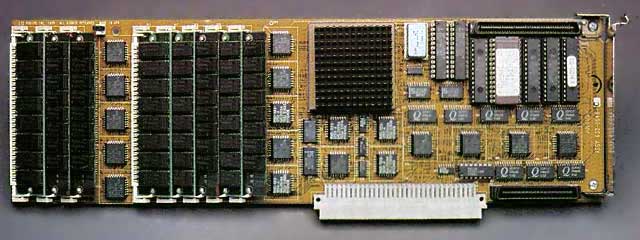The Radius Rocket was more than just another Macintosh accelerator* – it was essentially a 68040-based Mac on a NuBus card. With RocketShare, it is possible to put multiple Rockets in a NuBus Macintosh, each Rocket running its own copy of the Mac OS and handling its own set of tasks – or sharing a distributed workload.
Interesting tidbit: You can run a Radius Rocket in a Power Mac 7100 or 8100, which requires RocketShare 1.3 or later. It should also run in Radius’ Mac clones as well as other Mac clones built around NuBus architecture.
From MacUser, December 1991, p. 118, the same issue that introduced the Quadra 700 and 900:
The Rocket was designed in such a way that the processor on the Mac’s motherboard remained partially active, handling basic I/O functions. Radius has now announced Saturn V, a System 7 software extension for the Quadras that lets the processor on the motherboard remain completely active when a Rocket is installed.
Once a Saturn V-equipped Quadra has been launched, a Saturn V icon appears on the desktop. Double-clicking on the icon open a resizable windows with a complete desktop, including a menu bar and Trash. The mounted volumes on the host Quadra appear as AppleShare volumes in the Saturn V window.
Because the two 68040 processors – the one in the Rocket and the one in the Quadra – are both available for use, you can work in a foreground/background mode. So, for example, you can launch a complex 3-D rendering in the background on the Rocket while you continue to work with a spreadsheet or word-processing program on the Quadra. And because System 7’s IAC capabilities permit applications to support distributed processing, a Saturn V-equipped Quadra will be able to take advantage of applications that support distributed processing. It will be able to share a single task between the two processors, in effect cutting the processing time in half by applying twice the computing power to the job.
Radius expects to ship the Saturn V software in the first quarter of 1992.
Software for the Radius Rocket is no longer available at radiusvintage.com.
* The Stage II Rocket won’t work as an accelerator. It requires RocketShare to function.
- Got a Rocket? Join Rocketeer, our email list for Radius Rocket users.
Variants
- Radius Rocket 25i, 25 MHz 68LC040, part number unknown
- Radius Rocket 25, 25 MHz 68040, part number 0244
- Radius Rocket 33, 33 MHz 68040, part number 0330
- Radius Stage II Rocket, 40 MHz 68040, part number 0467
Details
- requires Mac with full sized NuBus slot and System 7.0.1 to 7.1 (System 7.5 compatible only with RocketShare)
- CPU: 25 MHz 68LC040; 25, 33, or 40 MHz 68040
- Bus: 10 MHz (standard NuBus speed)
- RAM: 8-128 MB using 100ns or faster (80ns preferred) 30 pin SIMMs in two banks of four; supports 1 MB, 4 MB, and 16 MB SIMMs; 16 MB SIMMs must support fast page mode; Radius recommends against using composite SIMMs; Stage II supports 60, 70, 80, and 100ns memory
- if you have a video card that is not Quadra compatible, you may need to upgrade video drivers, ROMs on the video card, or replace the card
- last version of Rocketware is 1.5; last version of RocketShare is 1.3.1
- Sound Manager 2.0 strongly recommended by users
Online Resources
- Rocketshare 1.3.1 is available for download.
- Radius Rocket: Far More than a Mac Accelerator, Tyler Sable, Classic Restorations, 2005.12.13. The unique Radius Rocket has amazing capabilities but challenges the user to take full advantage of them. Here are three modern options.
- Radius Rocket review, reproduced from MacUser, October 1991.
- Rocket Technical Overview, Joaquin Menchaca, DarkNerd
- The unofficial authoritative Radius Rocket FAQ, the pickle and b.b.
- Rocketeer, an email list for Radius Rocket users.
- Rocket Science 101, b.b., My Turn, 2000.10.30. Hands on tests with one or two Rockets in various Macs and Power Macs.
- Rocket Review by David Emmons
- Radius Rocket in Mac II, HyperArchive, 1992.02.11. Some very helpful info on the Rocket (does not cover Stage II)
Accessories
- SCSI 2 daughter card, part number 0368
- SCSI 2 daughter card for Stage II Rocket, part number 0434
- PhotoBooster, Photoshop DSP daughter card, part number 0396
- Rocketshare software
Keywords: #radiusrocket
Short link: http://goo.gl/Q1ghcf
searchword: radiusrocket


